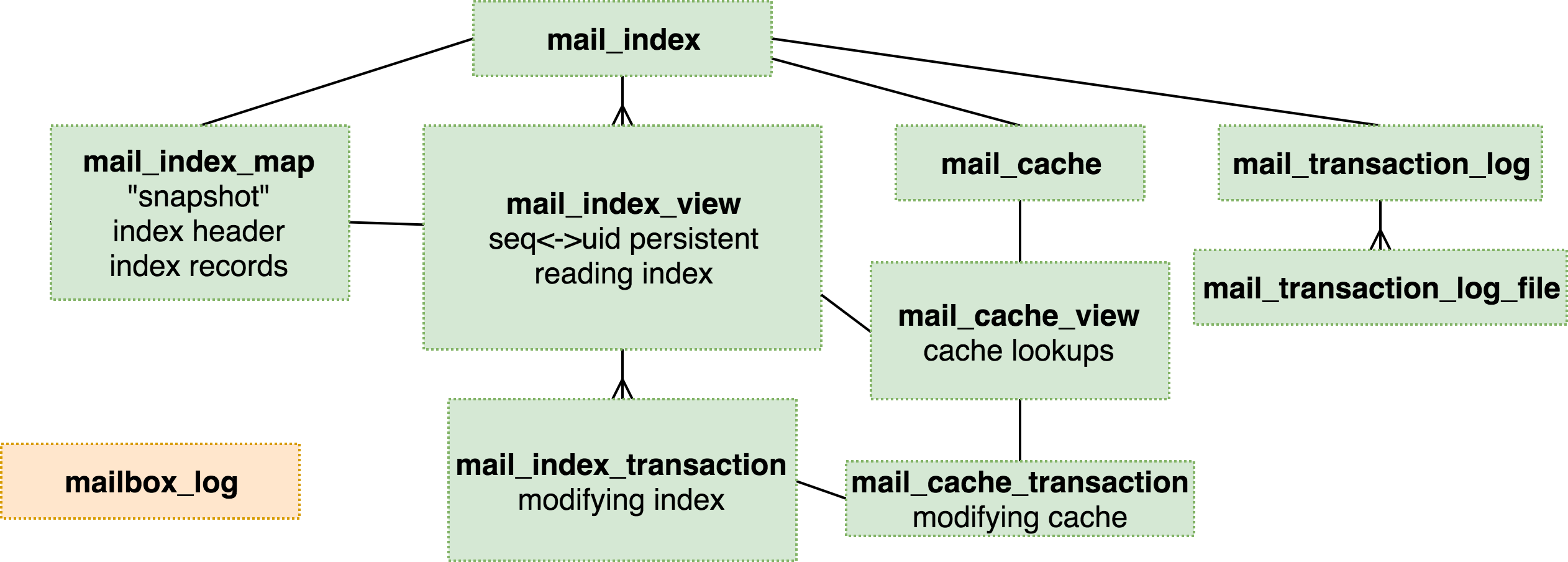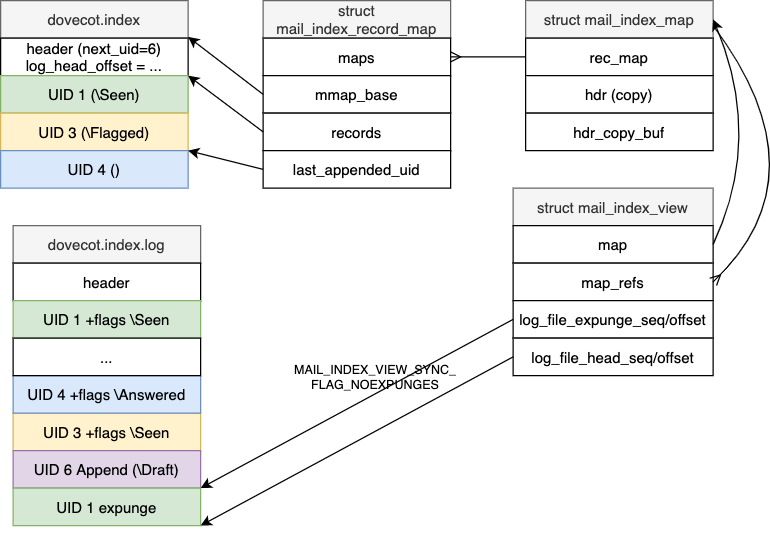Mail Index API

See Also
See Mail Indexes for an overview of what the cache does.
lib-index/mail-index.h contains the functions to access the index files. mail-cache.h contains the functions to access the cache file.
The purpose of the main structures are:
struct mail_index: Global state of the index.struct mail_index_view: View into the mailbox state, which contains the mail sequence <-> UID mapping. The views see new messages come and expunged messages go only when it's being explicitly synchronized. However, the record data (flags, keywords, extensions) can change without syncing. This is normally the wanted behavior anyway (e.g. there's no point accessing obsolete cache file offsets). An index can have many views. In lib-storage eachstruct mailboxhas a single view.struct mail_index_map: Index file is read via maps. A view has its primary map, but it can also reference other newer maps to return latest record data. Maps can be shared by different views. Maps can contain either mmap()ed memory areas pointing to the index file, or an in-memory copy of it.struct mail_index_transaction: In-memory list of changes to be written to the transaction log. The writing is done only when the transaction is committed.struct mail_transaction_log: Global state of the transaction log.struct mail_transaction_log_file: State of an opened transaction log file.struct mail_cache: Global state of the cache file.struct mail_cache_view: View for reading the cache file. The cache view references an index view.struct mail_cache_transaction: Transaction for modifying the cache file. A transaction references a cache view and index transaction.
See lib-index/*.h in the source code for details about these structs.
Views and Maps

The mail index API provides access to messages primarily using their message sequence number (MSN). This is the same as the IMAP MSNs. The first message has MSN=1, the second message 2 and so on. When a message is expunged, the MSNs change for all the messages following it. This means that the MSNs are highly stateful and can't be used as any kind of a permanent pointer to the message. IMAP UIDs provide such a permanent pointer instead (until UIDVALIDITY changes).
MSNs are always attached to a specific "view". The MSNs within the view don't change until an explicit "view sync" is performed. There can be multiple views to the same folder with different MSN mappings. This means that a view may include messages that have already been expunged. Their index record data is still available though, and their dovecot.index.cache data may also be still available.
There are APIs to convert between MSNs and UIDs. Converting UID to MSN requires doing a binary search through all the message records. It's fast, but still better avoided if not needed. This is one reason why all the API functions use MSNs instead of UIDs. Another reason is that IMAP protocol requires access by MSN in any case, so supporting MSNs directly makes them more efficient. The main downside to using MSNs is that whenever a message is expunged, we memmove() all the message data after it over the expunged message. This is typically not a big problem, because users usually expunge only new mails so the memmove()d size is rather small. If multiple mails are expunged at once, we'll also optimize so that we don't memmove() the same data multiple times. (The first Dovecot 0.99.x versions attempted to avoid this memmove() by tracking the mails in a binary tree, but this was optimizing a rarely problematic access pattern at the expense of a normal access pattern.)
Maps
A view points to a map, which points to a rec_map (struct mail_index_record_map).
The rec_map can be thought of as a mmap() of the index file. So the rec_map is the one that actually contains all the mail records. Multiple views can point to the same shared map, and multiple maps can point to the same shared rec_map. When messages are appended or expunged, the shared maps are copied into private maps.
Maps are updated whenever index file is refreshed, which can happen any time, not just when syncing index/view. The map is first built by reading or mmap()ing the dovecot.index file. The index header contains the file seq/offset to dovecot.index.log to indicate at which position it was created. All changes after this offset need to be read from the log and applied on top of the initial index. Later on when a map is being refreshed, only new changes from the dovecot.index.log file are read and applied.
View Syncing
Views are always synced up to a specific dovecot.index.log file seq/offset. IMAP protocol doesn't allow EXPUNGE notifications to be sent to the client in all situations, so a view sync can optionally sync the expunges or leave them to be synced later. This is why there are both "expunge" and "head" seq/offsets. The "expunge" points how far expunges have been synced, and the "head" how far everything else has.
View syncing returns a list of flag changes and modseq changes that happened during the sync. This is used to send change notifications to the IMAP sessions and for syncing virtual mailboxes.
It's possible that if a view hasn't been synced for a long time, it can point to a log file that has been rotated a few times already and no longer exists. In this situation Dovecot compares the original view's map and the latest map to find out the changes.
View APIs
For accessing messages with their UIDs, you'll first need to convert them to sequences with either mail_index_lookup_uid() or mail_index_lookup_uid_range().
mail_index_lookup() can be used to look up a single record's UID and flags. The returned record points to the latest map, so that it contains the latest flag and extension changes. If the message was already expunged from the latest map, it returns the old contents from the view's map. It's possible to find out whether a mail has been expunged from the latest map with mail_index_is_expunged().
mail_index_lookup_full() and mail_index_lookup_ext_full() can be used to return also the map where the message was found. This can be important with index extensions. If the extension record's state depends on the extension header or its reset_id, they must be looked up from the same map. For this reason there exists mail_index_map_get_header_ext() and other functions which take the map as parameter. For example a cache file offset that was looked up must be verified to be compatible with the current cache file by comparing the reset_id in the map vs cache file header.